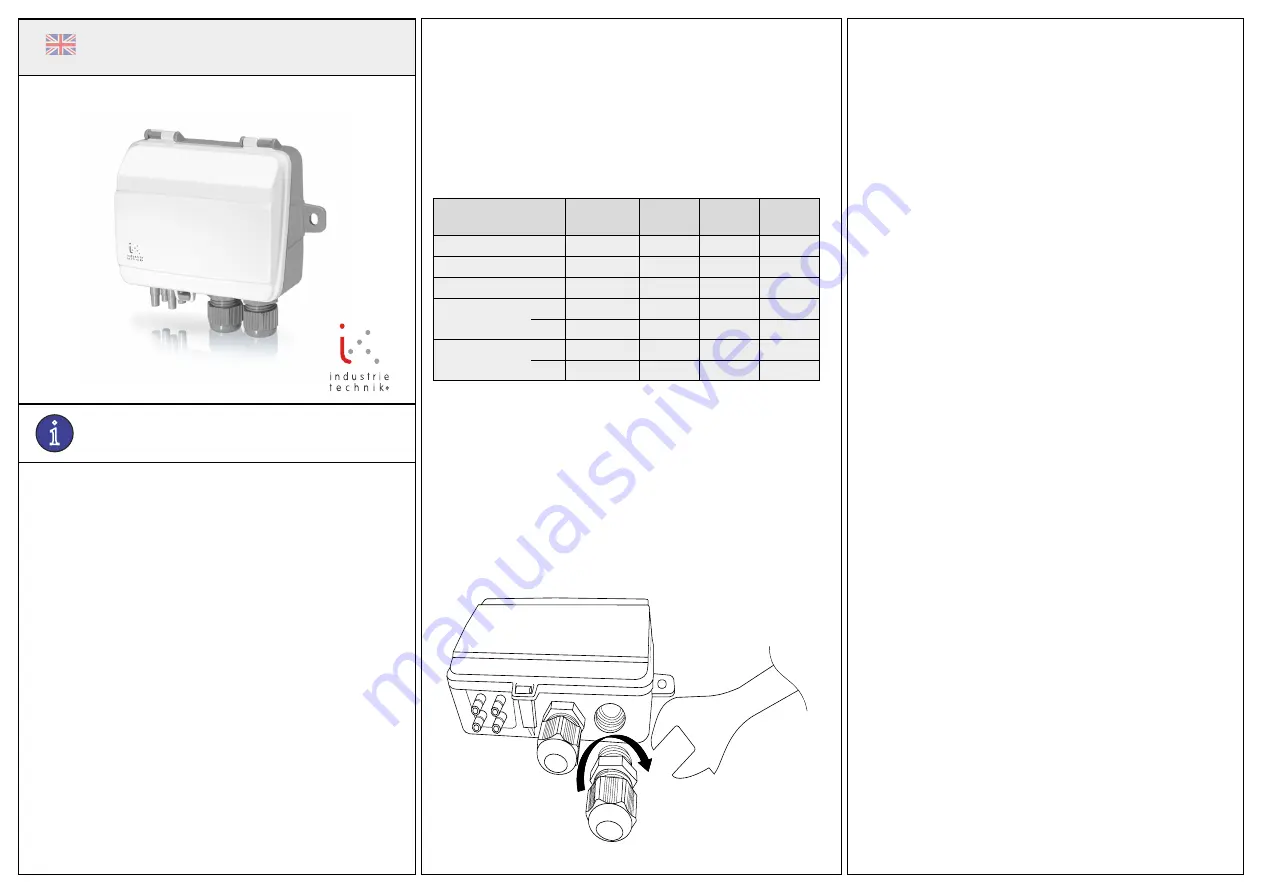
INSTRUCTION
i
Read this instruction before installation
and wiring of the product
Instruction TPDAxxxxAx
1
TPDAxxxxAx
Pressure transmitter
TPDA...A are single or dual port pressure transmitters with one or two
universal outputs for 0...10 V or 4...20 mA (selectable).
Technical data
Supply voltage
24 V AC/DC ±15 %
Protection class
IP54
Calculated power consumption
0...10 V mode
2 VA (rms) / min. trafo size 7.5 VA
4...20 mA mode
2.7 VA (rms) / min. trafo size 9 VA
Overall accuracy, pressure
≤ 1 % full scale
Annual deviation (typical)
P1250 models
±2 Pa
P2500 models
±4 Pa
P7500 models
±20 Pa
Damping (settable)
1, 2, 4 and 8 s
Operating temperature range -25…+50°C
Operating humidity
Max. 95 % RH (non-condensing)
Overvoltage on any terminal
Max. ±18 V (referenced to GND)
Universal outputs PS1, PS2
Configured as 0...10 V
Load impedance ≥ 10 kΩ,
Output impedance ≤ 35Ω
Configured as 4...20 mA
Output is actively sourced into a resistive
load impedance to signal ground. The
load impedance must be between
40...500Ω
Pressure ranges (full scale)
Model
Pressure
range (Pa)
mBar
mmH
2
O
inH
2
O
TPDA-12A
PS1
0…1250
0…12.5
0…125
0…5
TPDA-25A
PS1
0…2500
0…25
0…250
0…10
TPDA-75A
PS1
0…7500
0…75
0…750
0…30
TPDA-1225A2
PS1
0…1250
0…12.5
0…125
0…5
PS2
0…2500
0…25
0…250
0…10
TPDA-1275A2
PS1
0…1250
0…12.5
0…125
0…5
PS2
0…7500
0…75
0…750
0…30
Note:
The suffix in the name denotes the number of sensors in the unit.
The suffix “-2” indicates two sensors. No suffix means one sensor only.
Installation
The transmitter comes with one cable gland mounted and one loose. If
two cables are used, one for supply voltage and one for output signals,
the other cable gland must be assembled to the housing. Screw in the
cable gland until the plastic knockout in the housing snaps. Make sure to
remove the plastic knockout completely. Secure the cable gland.
1. Mount the transmitter horizontally or vertically on a stable,
vibration-free surface. If the unit is installed in a humid environ-
ment, install it vertically with the cable gland edge of the unit
pointing down to allow moisture to escape.
Take extra care when connecting the hoses to the inlet ports, as
the thin inner connections of the inlets are very sensitive. The lid
should be kept closed while performing the connections, or the
thin tubing might detach from the sensor.
2. Refer to the graphics below for wiring. Use the leftmost cable
gland for supply voltage and use the rightmost gland for output
signals in order to minimise crosstalk between supply wires and
signal wires.
3.
Set the DIP-switch to the desired operational mode and param-
eters.
4. Power up the unit.
5.
Let the unit warm up for 10 minutes, then perform a zero-set
calibration by pressing the pushbutton.
6. Connect plastic tubes from the ventilation duct to the pressure
inlets.
NOTE: A straight cut off nipple must be used for mounting in the
ventilation duct.
For optimal measuring results, measuring points with turbulent air
flow should be avoided. Preferably, measuring should be performed
at a distance of 2 duct diameters before bends and branching and at
6 duct diameters after bends and branching.
Wiring
1. G (+)
2. G0 (-)
3. UO1 +
4. UOI GND
5. UO2 +
6. UO2 GND
Terminals 2, 4 and 6 are galvanically the same (GND/G0).
For models with two sensors, the leftmost DIP-switch controls sensor
1 and the rightmost DIP-switch controls sensor 2 (see diagram 2
below).
12632 C
JUL
17
EN






















